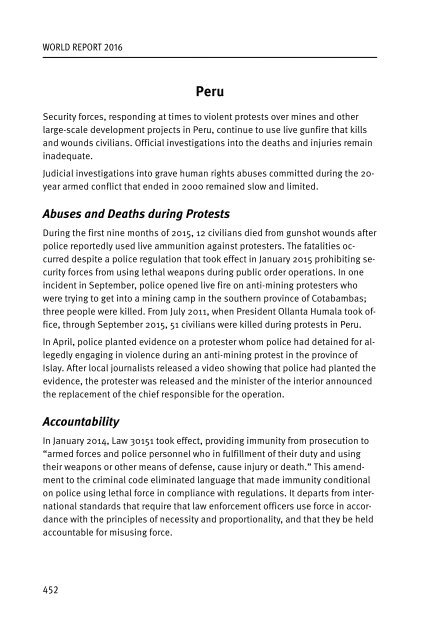Create successful ePaper yourself
Turn your PDF publications into a flip-book with our unique Google optimized e-Paper software.
WORLD REPORT 2016<br />
HUMAN RIGHTS WATCH<br />
Peru<br />
Security forces, responding at times to violent protests over mines and other<br />
large-scale development projects in Peru, continue to use live gunfire that kills<br />
and wounds civilians. Official investigations into the deaths and injuries remain<br />
inadequate.<br />
Judicial investigations into grave human rights abuses committed during the 20-<br />
year armed conflict that ended in 2000 remained slow and limited.<br />
Abuses and Deaths during Protests<br />
During the first nine months of 2015, 12 civilians died from gunshot wounds after<br />
police reportedly used live ammunition against protesters. The fatalities occurred<br />
despite a police regulation that took effect in January 2015 prohibiting security<br />
forces from using lethal weapons during public order operations. In one<br />
incident in September, police opened live fire on anti-mining protesters who<br />
were trying to get into a mining camp in the southern province of Cotabambas;<br />
three people were killed. From July 2011, when President Ollanta Humala took office,<br />
through September 2015, 51 civilians were killed during protests in Peru.<br />
In April, police planted evidence on a protester whom police had detained for allegedly<br />
engaging in violence during an anti-mining protest in the province of<br />
Islay. After local journalists released a video showing that police had planted the<br />
evidence, the protester was released and the minister of the interior announced<br />
the replacement of the chief responsible for the operation.<br />
Accountability<br />
In January 2014, Law 30151 took effect, providing immunity from prosecution to<br />
“armed forces and police personnel who in fulfillment of their duty and using<br />
their weapons or other means of defense, cause injury or death.” This amendment<br />
to the criminal code eliminated language that made immunity conditional<br />
on police using lethal force in compliance with regulations. It departs from international<br />
standards that require that law enforcement officers use force in accordance<br />
with the principles of necessity and proportionality, and that they be held<br />
accountable for misusing force.<br />
In July 2015, the Constitutional Court ruled that military courts could not try members<br />
of the military accused of committing abuses against civilians in public security<br />
operations. In the case, brought by Peruvian human rights activists in<br />
2011, the court provided a restrictive interpretation of a decree adopted by President<br />
Alan García in 2010 that had opened the door to trying such cases in military<br />
courts. However, Law 30151 continues to restrict police accountability.<br />
In August, President Humala, who signed law 30151, issued a decree that limits<br />
the use of force by police. Under the decree, police should only employ lethal<br />
force when it is “strictly necessary” in the face of a “serious and imminent risk”<br />
of grave harm. But with Law 30151 limiting criminal accountability, it remains to<br />
be seen how the decree will affect police behavior.<br />
In cases of excessive use of force against protesters documented by local human<br />
rights groups from 2002 through August 2015, not a single official was convicted.<br />
Less than one in five cases was being prosecuted at the time of writing,<br />
according to local human rights groups.<br />
Confronting Past Abuses<br />
Peru’s Truth and Reconciliation Commission has estimated that almost 70,000<br />
people died or were subject to enforced disappearance during the country’s<br />
armed conflict between 1980 and 2000. Many were victims of atrocities by the<br />
Shining Path and other insurgent groups; others were victims of human rights violations<br />
by state agents.<br />
In a landmark trial, former President Alberto Fujimori was sentenced in 2009 to<br />
25 years in prison for killings and “disappearances” in 1991 and 1992. Courts<br />
have consistently rejected petitions to reverse his sentence. Fujimori’s intelligence<br />
advisor, Vladimiro Montesinos, three former army generals, and members<br />
of the Colina group, a government death squad, are also serving sentences ranging<br />
from 15 to 25 years for the assassination in 1991 of 15 people in the Lima district<br />
of Barrios Altos, and for six “disappearances.”<br />
Courts have made much less progress in addressing violations that occurred<br />
under the earlier administrations of Fernando Belaúnde (1980-1985) and Alan<br />
García (1985-1990). In a report issued in August 2013 to mark the 10th anniversary<br />
of the Truth and Reconciliation Commission’s final report, the human rights<br />
452<br />
453


